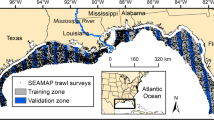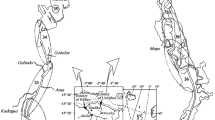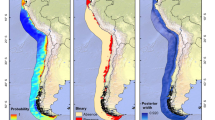Abstract
Estuarine ecosystems along the Pacific coast of North America are vulnerable to invasions by non-indigenous planktonic copepods, with documented invasions by at least nine species introduced via ship’s ballast. One of these, the calanoid copepod Pseudodiaptomus inopinus, now occurs in a relatively wide geographical area in coastal estuaries of Washington and Oregon States. Although it appears to be well established in the region, plankton surveys conducted in 1992, 1996, 2000, and 2004 in estuaries from southern Vancouver Island in British Columbia, Canada, to northern California, United States indicate that it has not expanded its range. This static distribution suggests that P. inopinus has reached a distributional limit, and it may thus be a good organism for applying models for predicting planktonic invasions, by characterizing estuaries with and without populations of the copepod. In this study, we applied both parametric, linear (discriminant function analysis, logistic regression) and nonparametric, non-linear (classification trees) techniques to develop models for occurrence of P. inopinus, to identify parameters that may lead to successful invasions and to identify specific estuaries or regions that might be at risk of invasion by this species. Both model types had similar results, identifying relatively simple salinity- and stratification-based models as good predictors of P. inopinus. While different models selected slightly different sets of variables and thresholds, all models identified relatively low salinity and stratification of water column temperature and salinity as important predictors of P. inopinus presence. The models also identified several “false positives” that mainly occurred in more inland waters of Puget Sound—estuaries that did not have P. inopinus, but had the conditions that support it, and which may be at risk for future invasions by this species.








Similar content being viewed by others
References
Allen YC, Ramcharan CW (2001) Dreissena distribution in commercial waterways of the US: using failed invasions to identify limiting factors. Can J Fish Aquat Sci 58:898–907
Beaugrand G, Reid PC, Ibañez F, Lindley AJ, Edwards M (2002) Reorganization of North Atlantic marine copepod biodiversity and climate. Science 296:1692–1694
Benoit HP, Johannsson OE, Warner DM, Sprules WG, Rudstam LG (2002) Assessing the impact of a recent predatory invader: the population dynamics, vertical distribution, and potential prey of Cercopagis pengoi in Lake Ontario. Limnol Oceanogr 47:626–635
Bollens SM, Cordell JR, Avent S, Hooff R (2002) Occurrences, causes and consequences of zooplankton invasions: a brief review, plus two case studies from the northeast Pacific Ocean. Hydrobiologia 480:87–110
Boudreau SA, Yan ND (2003) The differing crustacean zooplankton communities of Canadian Shield lakes with and without the nonindigenous zooplanktivore Bythotrephes longimanus. Can J Fish Aquat Sci 60:1307–1313
Breiman L, Friedman JH, Olshen A, Stone CG (1984) Classification and regression trees. Wadsworth International Group, Belmont
Buchan LAJ, Padilla DK (2000) Predicting the likelihood of Eurasian Watermilfoil presence in lakes, a macrophyte monitoring tool. Ecol Appl 10:1442–1455
Cordell JR, Morrison SM (1996) The invasive Asian copepod Pseudodiaptomus inopinus in Oregon, Washington, and British Columbia estuaries. Estuaries 19:629–638
Cordell JR, Morgan CA, Simenstad CA (1992) Occurrence of the Asian calanoid copepod Pseudodiaptomus inopinus in the zooplankton of the Columbia River estuary. J Crust Biol 12:260–269
Cordell JR, Rassmussen M, Bollens SM (2007) Biology of the invasive copepod Pseudodiaptomus inopinus in a northeast Pacific estuary. Mar Ecol Progr Ser 333:213–227
Cordell JR, Bollens SM, Draheim R, Sytsma M (2008a) Asian copepods on the move: recent invasions in the Columbia–Snake River system, USA. ICES J Mar Sci 65:000
Cordell JR, Lawrence DA, Ferm NC, Tear LM, Smith SS, Herwig RP (2008b) Factors influencing densities of non-indigenous species in the ballast water of ships arriving at ports in Puget Sound, Washington, United States. Aquat Conserv: Mar Freshw Ecosyst 19:322–343
De’ath G, Fabricius KE (2000) Classification trees: a powerful yet simple technique for ecological data analysis. Ecology 81:3178–3192
Drake JM, Bossenbroek JM (2004) The potential distribution of zebra mussels in the United States. Bioscience 54:931–941
Drake JM, Lodge DM (2006) Forecasting potential distributions of nonindigenous species with a genetic algorithm. Fisheries 31:9–16
Dzialowski AR, Lennon JT, Smith VH (2007) Food web structure provides biotic resistance against plankton invasion attempts. Biol Invasions 9:257–267
Elith J et al (2006) Novel methods improve prediction of species distributions from occurrence data. Ecography 29:129–151
Finenko GA, Kideys AE, Anninsky BE, Shiganova TA, Roohi A, Tabari MR, Rostami H, Bagheri S (2007) Invasive ctenophore Mnemiopsis leidyi in the Caspian Sea: feeding, respiration, reproduction and predatory impact on the zooplankton community. Mar Ecol Prog Ser 314:171–185
Gorokhova E, Lehtiniemi M (2007) A combined approach to understand trophic interactions between Cercopagis pengoi (Cladocera: Onychopoda) and mysids in the Gulf of Finland. Limnol Oceanogr 52:685–695
Gorokhova E, Aladin N, Dumont H (2000) Further range extensions of Cercopagis genus (Crustacea, Cladocera) with notes on taxonomic composition and ecology. Hydrobiologia 429:207–218
Guisan A, Zimmerman NE (2000) Predictive habitat distribution models in ecology. Ecol Model 135:147–186
Haslob H, Clemmesen C, Schaber M, Hinrichsen H, Schmidt JO, Voss R, Kraus G, Köster FW (2007) Invading Mnemiopsis leidyi as a potential threat to Baltic fish. Mar Ecol Prog Ser 349:303–306
Havel JE, Shurin JB, Jones JR (2005) Environmental limits to a rapidly spreading exotic cladoceran. Ecoscience 2:376–385
Herborg L-M, Jerde CL, Lodge DM, Ruiz GM, MacIsaac HJ (2007a) Predicting invasion risk using measures of introduction effort and environmental niche models. Ecol Appl 17:663–674
Herborg L-M, Rudnick DA, Siliang Y, Lodge DM, MacIsaac HJ (2007b) Predicting the range of Chinese mitten crabs in Europe. Conserv Biol 21:1316–1323
Hooff RC, Bollens SM (2004) Functional response and potential predatory impact of Tortanus dextrilobatus, a carnivorous copepod recently introduced to the San Francisco Estuary. Mar Ecol Prog Ser 277:167–179
Hovius JT, Beisner BE, McCann KS, Yan ND (2007) Indirect food web effects of Bythotrephes invasion: responses by the rotifer Conochilus in Harp Lake, Canada. Biol Invasions 9:233–243
Islam MS, Ueda H, Tanaka M (2006) Spatial and seasonal variations in copepod communities related to turbidity maximum along the Chikugo estuarine gradient in the upper Ariake Bay, Japan. Est Coast Shelf Sci 68:113–126
Jones LA, Ricciardi A (2005) Influence of physicochemical factors on the distribution and biomass of invasive mussels (Dreissena polymorpha and Dreissena bugensis) in the St. Lawrence River. Can J Fish Aquat Sci 62:1953–1962
Kideys AE (2002) Fall and rise of the Black Sea ecosystem. Science 297:1482–1484
Lehtiniemi M, Gorokhova E (2008) Predation of the introduced cladoceran Cercopagis pengoi on the native copepod Eurytemora affinis in the northern Baltic Sea. Mar Ecol Prog Ser 362:193–200
Levings CD, Cordell JR, Ong S, Piercey GE (2004) The origin and identity of invertebrate organisms being transported to Canada’s Pacific coast by ballast water. Can J Fish Aquat Sci 61:1–11
Loo SE, MacNally R, Lake PS (2007) Forecasting New Zealand mudsnail invasion range: model comparisons using native and invaded ranges. Ecol Appl 17:181–189
MacIsaac HJ, Borbely JVM, Muirhead JR, Graniero PA (2004) Backasting and forecasting biological invasions of inland lakes. Ecol Appl 14:773–783
Marchetti MP, Moyle PB, Levine R (2004) Invasive species profiling? Exploring the characteristics of non-native fishes across invasion stages in California. Freshw Biol 49:646–661
Mercado-Silva N, Olden JD, Maxted JT, Hrabik TR, Vander Zanden MJ (2006) Forecasting the spread of invasive rainbow smelt in the Laurentian Great Lakes region of North America. Conserv Biol 20:1740–1749
Ojaveer H, Simm M, Lankov A (2004) Population dynamics and ecological impact of the non indigenous Cercopagis pengoi in the Gulf of Riga (Baltic Sea). Hydrobiologia 522:261–269
Olden JD, Jackson DA (2002) A comparison of statistical approaches for modelling fish species distributions. Freshw Biol 47:1976–1995
Orsi JJ, Ohtsuka S (1999) Introduction of the Asian copepods Acartiella sinensis, Tortanus dextrilobatus (Copepoda: Calanoida), and Limnoithona tetraspina (Copepoda: Cyclopoida) to the San Francisco Estuary, California, USA. Plankton Biol Ecol 46:128–131
Panov E, Rodionova V, Bolshagin PV, Bychek EA (2007) Invasion biology of Ponto-Caspian cladoceran cladocerans (Crustacea: Cladocera). Hydrobiologia 590:3–14
Peterson AT (2003) Predicting the geography of species’ invasions via ecological niche modelling. Quart Rev Biol 78:419–433
Rahel FJ, Olden JD (2008) Assessing the effects of climate change on aquatic invasive species. Conserv Biol 22:521–533
Rejwan C, Collins NC, Brunner J, Shuter BJ, Ridgway MS (1999) Tree regression analysis on the nesting habitat of smallmouth bass. Ecology 80:341–348
Ruesink JL (2005) Global analysis of factors affecting the outcome of freshwater fish introductions. Conserv Biol 19:1883–1893
Ruiz GM, Fofonoff PW, Carlton JT, Wonham MJ, Hines AH (2000) Invasion of coastal marine communities in North America: apparent patterns, processes, and biases. Ann Rev Ecol and Syst 31:481–531
Steiner FM, Schlick-Steiner BC, VanDerWal J, Reuther KD, Christian E, Stauffer C, Suarez AV, Williams SE, Crozier RH (2008) Combined modelling of distribution and niche in invasion biology: a case study of two invasive Tetramorium ant species. Divers Distr 14:538–545
Suh H-L, Soh HY, Cha SS (1991) Salinity and distribution of zooplankton in the estuarine system of Mankyong river and Dongjin river. J Oceanol Soc Korea 3:181–192
Sullivan BK, Costello JH, Van Keuren D (2007) Seasonality of the copepods Acartia hudsonica and Acartia tonsa in Narragansett Bay, RI, USA during a period of climate change. Est Coast Shelf Sci 73:259–267
Therriault TW, Grigorovich IA, Kane DD, Haas EM, Culver DA, MacIsaac HJ (2002) Range expansion of the exotic zooplankter Cercopagis pengoi (Ostroumov) into western Lake Erie and Muskegon Lake. J Gt Lakes Res 28:698–701
Ueda H, Terao A, Tanaka M, Hibino M, Islam MS (2004) How can river-estuarine planktonic copepods survive river floods? Ecol Res 19:625–632
Yan ND, Pawson TW (1997) Changes in the crustacean zooplankton community of Harp L. Canada, following invasion by Bythotrephes cederstroemi. Freshw Biol 37:409–425
Yan ND, Girard R, Boudreau S (2002) An introduced invertebrate predator (Bythotrephes) reduces zooplankton species richness. Ecol Lett 5:481–485
Acknowledgments
Many students and staff from the Wetland Ecosystems Team, University of Washington helped with sample collections. O. Kalata analyzed the majority of the zooplankton samples. J. Olden provided a thoughtful and comprehensive review that improved the manuscript. This research was sponsored in part by Washington State Sea Grant.
Author information
Authors and Affiliations
Corresponding author
Rights and permissions
About this article
Cite this article
Cordell, J.R., Tear, L.M. & Bollens, S.M. Modelling physico-chemical factors affecting occurrences of a non-indigenous planktonic copepod in northeast Pacific estuaries. Biol Invasions 12, 1427–1445 (2010). https://doi.org/10.1007/s10530-009-9558-5
Received:
Accepted:
Published:
Issue Date:
DOI: https://doi.org/10.1007/s10530-009-9558-5




